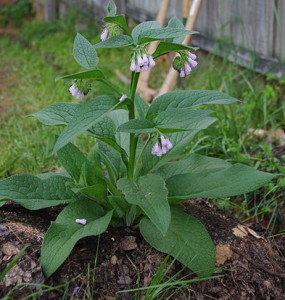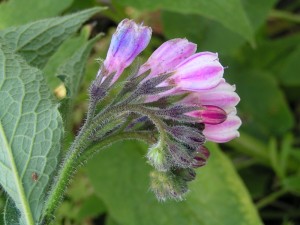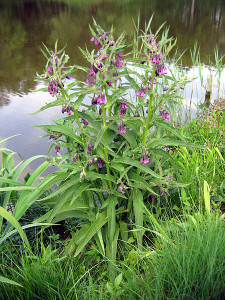
Russian comfrey (Symphytum × uplandicum x Bocking) Finchj – Own work
Hello fellow readers,
Jacquie from Andover bought some comfrey seeds to try. She heard comfrey leaves are great for the soil and it’s true. Common Comfrey (Symphytum officinalis), native to Europe, can juice up your garden with nutrients. But before you opt to plant it, consider that these three to four-foot big boys are aggressive spreaders by self-seeding and via their roots. Even a small segment of a root can grow into a plant; so no digging around your comfrey to help prevent spreading. There’s Bocking 14 cultivars (Symphytum x uplandicum) also known as Russian Comfrey, which is a sterile hybrid that won’t self-seed. It’s become the comfrey of choice. Its course leaf structure is quite striking in a roomy setting; thriving in moist clay soil in full sun or part shade. Comfrey roots go down six feet absorbing nutrients from deep in the earth. Their leaves are rich with nitrogen, phosphorus, and potassium; they say 2 to 3 times more potassium than manure.
In the first year, it’s best not to harvest; cutting off flowers as they form, to encourage root development. The next year, harvest when plants are about 2 feet tall or when flower stalks begin to form. Cut the whole plant down two inches above the ground. Each plant produces 4 to 5 pounds of leaves per cutting. With harvests every 5 weeks, six plants are enough for most folks.
If you fill a covered trash with half water, half comfrey leaves and steep for 3 to 6 weeks, you’ll end up with a very stinky brew that’s a beneficial tea for your plants. You can use full strength or dilute in half each time you water. Or make a liquid concentrate, compacting fresh cut leaves and weighing them down with rocks or a sealed plastic bag filled with water. Cover tightly and in a few weeks it will turn into a black sludge. Some drill a hole on the bottom of their trash can and let the liquid gold drip into a lower container. Yup, its smelly too, but oh so good for your plants. Dilute 15 to 1, water to sludge, to fertilize.
I’ve heard you can grow comfrey in trash cans; a great solution if you have limited space. Be sure to cut drainage holes in the bottom. I’m visualizing an assembly line of sorts that can be made into a funky garden feature. A trash can for growing. Next to it, a trash can for making tea. And, if you’re going for the concentrate, one below to capture the sludge. Stinky trash can garden art! Hey, it’s in the eye of the beholder. Garden Dilemmas? askmarystone@gmail.com

The flowers of Russian comfreyen: Sannse

Symphytum officinale, Wrocław, Poland


